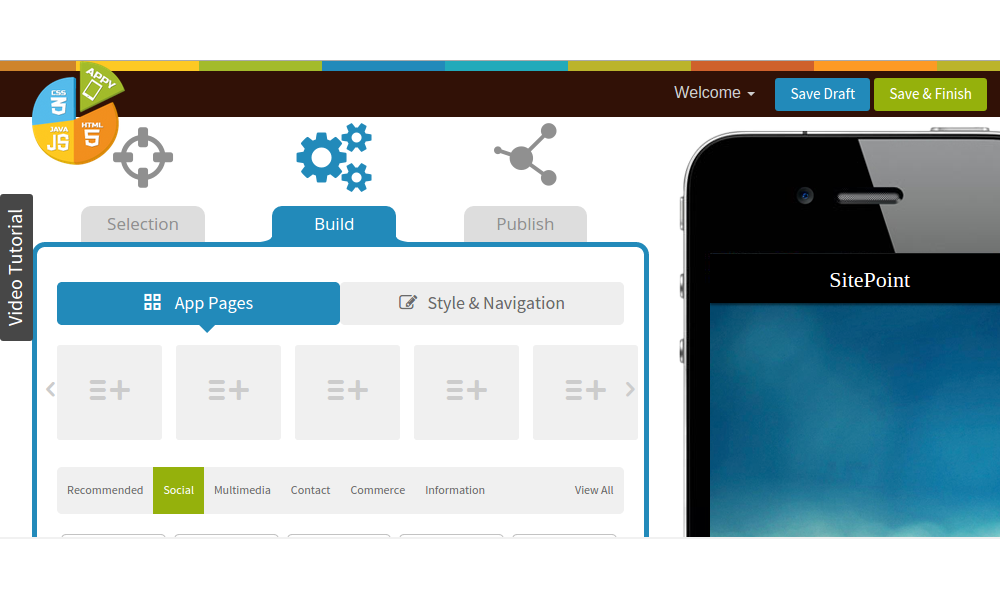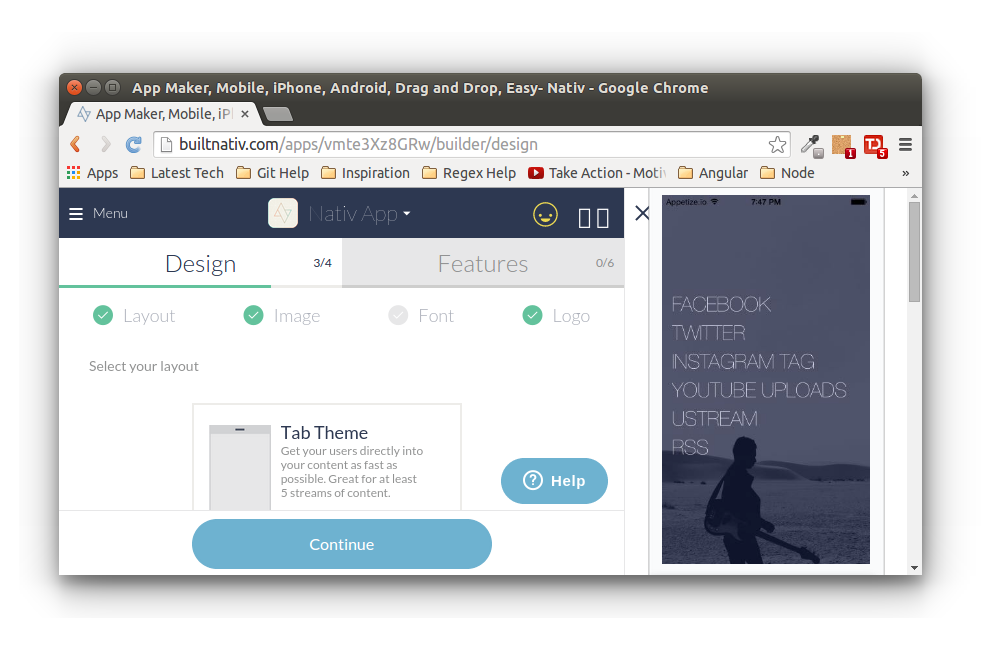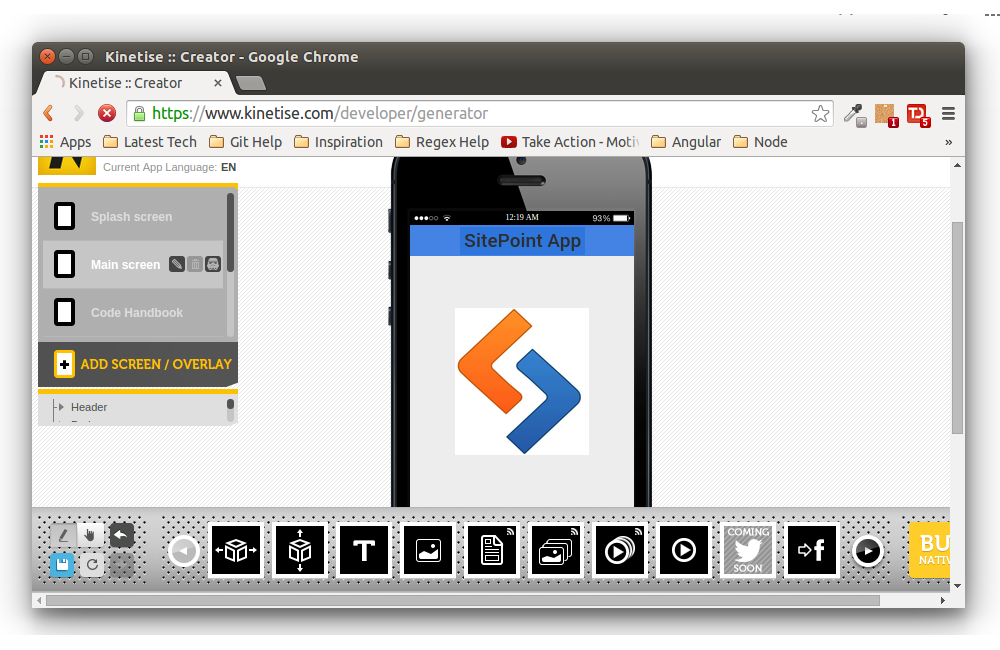3 Creating Mobile Apps
There was a time when mobile application development was only for the elite programmer (i.e. people who knew the native platform language). With the dawn of hybrid mobile application technology, it was possible to create mobile applications using HTML, CSS and JavaScript. Hybrid application development made it possible for non-mobile developers to get their hands dirty with mobile app development.
But what about those people who don't have any prior programming knowledge? Can they make a mobile applications on their own?
They certainly can.
There was a time when mobile application development was only for the elite programmer (i.e. people who knew the native platform language). With the dawn of hybrid mobile application technology, it was possible to create mobile applications using HTML, CSS and JavaScript. Hybrid application development made it possible for non-mobile developers to get their hands dirty with mobile app development.
But what about those people who don't have any prior programming knowledge? Can they make a mobile applications on their own?
They certainly can.
More from this author
Is it possible to make any app without code ?
No. There are several web services which enable users to create simple mobile applications. As of now, you can't rely on these web applications to help create complex mobile applications. But they may surprise you in the future.
In this article, we'll look at some services which enable people with no prior programming knowledge to create simple mobile applications.
No. There are several web services which enable users to create simple mobile applications. As of now, you can't rely on these web applications to help create complex mobile applications. But they may surprise you in the future.
In this article, we'll look at some services which enable people with no prior programming knowledge to create simple mobile applications.
Appy Pie
To get started with Appy Pie, sign up for an account and sign in. Once signed in you should see a link to create a new app.
Creating an app using Appy Pie is a 3 step process:
- select a category
- build your app
- publish.
Start building an app by entering a name and selecting a category. Based on the category it will have some default splash and background images which you can change later.
Once on the second page, you have the options to add pages to your app, style your app and change the app navigation.
 You can add different pages to your mobile app by clicking on the icons listed below. To customize the look and feel of your app click on the Style & Navigation tab. Styling and navigation options are neatly placed under a single tab and hence accessible.
Once finished with modifying the style and navigation of your mobile app, click on the publish tab to proceed. Based on your subscription plan you should be able to publish to an app store or test the app on your mobile.
Based on your pricing plan you will be able to use Push Notifications, Ads etc. in your mobile apps. You'll need a developer account to publish to the Apple app store or Google play store.
On the Appy Pie market place you can preview mobile apps created using the service.
You can add different pages to your mobile app by clicking on the icons listed below. To customize the look and feel of your app click on the Style & Navigation tab. Styling and navigation options are neatly placed under a single tab and hence accessible.
Once finished with modifying the style and navigation of your mobile app, click on the publish tab to proceed. Based on your subscription plan you should be able to publish to an app store or test the app on your mobile.
Based on your pricing plan you will be able to use Push Notifications, Ads etc. in your mobile apps. You'll need a developer account to publish to the Apple app store or Google play store.
On the Appy Pie market place you can preview mobile apps created using the service.
To get started with Appy Pie, sign up for an account and sign in. Once signed in you should see a link to create a new app.
Creating an app using Appy Pie is a 3 step process:
- select a category
- build your app
- publish.
Start building an app by entering a name and selecting a category. Based on the category it will have some default splash and background images which you can change later.
Once on the second page, you have the options to add pages to your app, style your app and change the app navigation.

You can add different pages to your mobile app by clicking on the icons listed below. To customize the look and feel of your app click on the Style & Navigation tab. Styling and navigation options are neatly placed under a single tab and hence accessible.
Once finished with modifying the style and navigation of your mobile app, click on the publish tab to proceed. Based on your subscription plan you should be able to publish to an app store or test the app on your mobile.
Based on your pricing plan you will be able to use Push Notifications, Ads etc. in your mobile apps. You'll need a developer account to publish to the Apple app store or Google play store.
On the Appy Pie market place you can preview mobile apps created using the service.
Nativ
To get started with Nativ, sign up for a free account.
You can start creating a mobile app by choosing a template for the app. After choosing the template you should be presented with a screen with two tabs, Design and Features.
 Layout, background image, font and logo can be modified under the design tab. Under the features tab you can select from a list of different streams that can be added to your app. Nativ has streams like facebook, twitter, PDF reader etc. Some streams like WordPress and Chat should be available soon.
Once you have completed your app, you should be able to see a preview on the right side of the screen. When you are finished, click the finish the app button.
By default nativ publishes the app under their own developer account but you can also publish under yours. Push notification features are available only under paid plans.
More info can be found in their faq.
Layout, background image, font and logo can be modified under the design tab. Under the features tab you can select from a list of different streams that can be added to your app. Nativ has streams like facebook, twitter, PDF reader etc. Some streams like WordPress and Chat should be available soon.
Once you have completed your app, you should be able to see a preview on the right side of the screen. When you are finished, click the finish the app button.
By default nativ publishes the app under their own developer account but you can also publish under yours. Push notification features are available only under paid plans.
More info can be found in their faq.
To get started with Nativ, sign up for a free account.
You can start creating a mobile app by choosing a template for the app. After choosing the template you should be presented with a screen with two tabs, Design and Features.

Layout, background image, font and logo can be modified under the design tab. Under the features tab you can select from a list of different streams that can be added to your app. Nativ has streams like facebook, twitter, PDF reader etc. Some streams like WordPress and Chat should be available soon.
Once you have completed your app, you should be able to see a preview on the right side of the screen. When you are finished, click the finish the app button.
By default nativ publishes the app under their own developer account but you can also publish under yours. Push notification features are available only under paid plans.
More info can be found in their faq.
Kinetise
Although Kinetise is in beta, it's more appealing to me due to its look and feel. When you click on thecreate app button you are presented with an app preview in the middle of the page with customization options on the side which gives it a different feel (or so it seemed to me).
 You can start by selecting any particular app type or begin with an blank template and click Start Building. On the next screen, you can see Kinetise has the option to drag and drop widgets and controls onto the app. Widgets are displayed on the bottom of the page and can include text, images, video, gallery etc.
You can start by selecting any particular app type or begin with an blank template and click Start Building. On the next screen, you can see Kinetise has the option to drag and drop widgets and controls onto the app. Widgets are displayed on the bottom of the page and can include text, images, video, gallery etc.
 On the left side of the screen you can see options to edit the splash screen, main screen and to add new screens. Once new screens have been added by clicking add screen on the left hand side, it's added to the bottom of the app.
To emulate the app, click in the preview screen and you need to right click on the preview screen.
At the top of the preview screen you can see options to view the app on different platforms. There is a button above the preview to change the app mode to portrait or landscape.
Once you are finished designing the app, click on the build native app button in the bottom right corner. After the build has finished you have a web preview or a build for your native platform.
Based on your pricing plan you can have features like push notification, publishing to app stores etc. In case you don't have a developer account for Android or Apple, Kinetise can publish the app using their own developer account for a small fee.
Here is a preview of an app created using Kinetise.
On the left side of the screen you can see options to edit the splash screen, main screen and to add new screens. Once new screens have been added by clicking add screen on the left hand side, it's added to the bottom of the app.
To emulate the app, click in the preview screen and you need to right click on the preview screen.
At the top of the preview screen you can see options to view the app on different platforms. There is a button above the preview to change the app mode to portrait or landscape.
Once you are finished designing the app, click on the build native app button in the bottom right corner. After the build has finished you have a web preview or a build for your native platform.
Based on your pricing plan you can have features like push notification, publishing to app stores etc. In case you don't have a developer account for Android or Apple, Kinetise can publish the app using their own developer account for a small fee.
Here is a preview of an app created using Kinetise.
Although Kinetise is in beta, it's more appealing to me due to its look and feel. When you click on thecreate app button you are presented with an app preview in the middle of the page with customization options on the side which gives it a different feel (or so it seemed to me).

You can start by selecting any particular app type or begin with an blank template and click Start Building. On the next screen, you can see Kinetise has the option to drag and drop widgets and controls onto the app. Widgets are displayed on the bottom of the page and can include text, images, video, gallery etc.

On the left side of the screen you can see options to edit the splash screen, main screen and to add new screens. Once new screens have been added by clicking add screen on the left hand side, it's added to the bottom of the app.
To emulate the app, click in the preview screen and you need to right click on the preview screen.
At the top of the preview screen you can see options to view the app on different platforms. There is a button above the preview to change the app mode to portrait or landscape.
Once you are finished designing the app, click on the build native app button in the bottom right corner. After the build has finished you have a web preview or a build for your native platform.
Based on your pricing plan you can have features like push notification, publishing to app stores etc. In case you don't have a developer account for Android or Apple, Kinetise can publish the app using their own developer account for a small fee.
Here is a preview of an app created using Kinetise.
Conclusion
8 Great Free Flipped Classroom Resources
These Resources and Applications Make Excellent Additions to Your Flipped Instruction Tools Set
ed.ted.com: This cool tool lets you take any video on YouTube and deliver it in a private mode to whoever you choose to share it with, but its real power comes from the ability to create a quiz, supporting links, and “dig deeper” content that you can associate with the video (you can review the responses online).
Screencast-O-Matic: When you’re ready to give screen casting a try, Screencast-O-Matic was one of the first screencasting tools to be published that’ still around. It works with both the Mac and the PC, and requires no installation. There’s a quick demo video on the home page. You can record and host 15 minute clips for free, and create unlimited clips if you have the Pro version, available for just $15 a year.
PowerPoint’s Voice Annotation Function: Many teachers use PowerPoint slides as a part of their lecturing process. Adding your voice to these slides is pretty easy to do, turning a presentation from a plain set of slides into a self-contained instructional asset that stands alone. This can be a great way to test the waters with flipped content delivery. Get a quick overview of how easy it is to do this inthis video.
Wikispaces: If you don’t have somewhere to deliver your content, a Wiki is a great place to start. Creating simple web pages with text, images, videos, links, and more is a snap with Wikispaces. This wiki is very popular with teachers, for good reason.
Online Videos and Classes: This article offers 7 free online education video resources teachers can use when they are looking for videos to help reinforce what they are teaching, or to provide a different perspective. These videos and video courses come from a wide variety of experts and thought leaders, and many provide an entertaining or thought provoking examination of academic topics.
Tackk: An easy tool for creating digital assignments … homework, flipped class content, blended learning lesson material, etc. Tackk is an Internet based application that provides an easy to use interface enabling you to post an image, video, or other content and add some text so you can ask questions or post some other form of assignment. A comments section is automatically available for each piece of content, so there’s an instant discussion forum! View an example Tackk and learn more here.
Creating Engaging Screencasts: The low cost of good quality web cams and the availability of free or relatively inexpensive screencasting applications helps to make the development of video learning content easier than ever. Yet all the free or low cost tools in the world do not inevitably yield good quality results. There is an essential element of technique to be considered. If one is going to invest time and energy (and budget dollars) in tools for the creation of video content, it is highly advisable to learn a bit about how to do what you are doing well. This article,Dozens of Tips & Techniques for Creating High Quality Engaging Screencasts, provides a wealth of insights and ideas to help you make the best of your screencasting efforts. This video is a companion to the article.
Edmodo: Edmodo is a powerful, much loved application in the K-12 world. The rich functionality offered by this education-specific course deliver tool is very impressive for a free (and ad-free) application. Click over to this article, “10 Reasons Why Edmodo is an Excellent (and Hugely Popular) Digital Learning Platform” to dive into the many reasons why you will want to know about Edmodo if you don’t already have a digital learning platform. This video provides an overview of the article’s content.
For more free flipped teaching and learning resources, sign up to have blog posts emailed to have the excellent 2014 Free Flipped Teaching & Learning Resources eBook sent to you as a thank you gift!




No comments:
Post a Comment